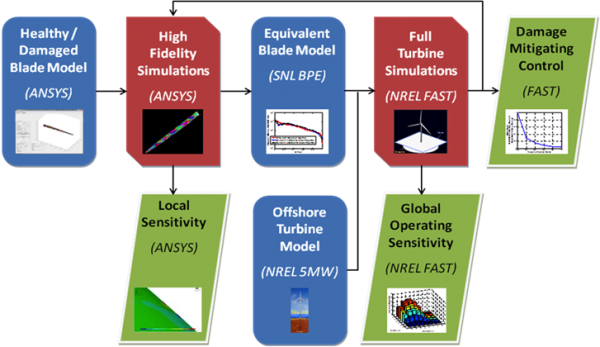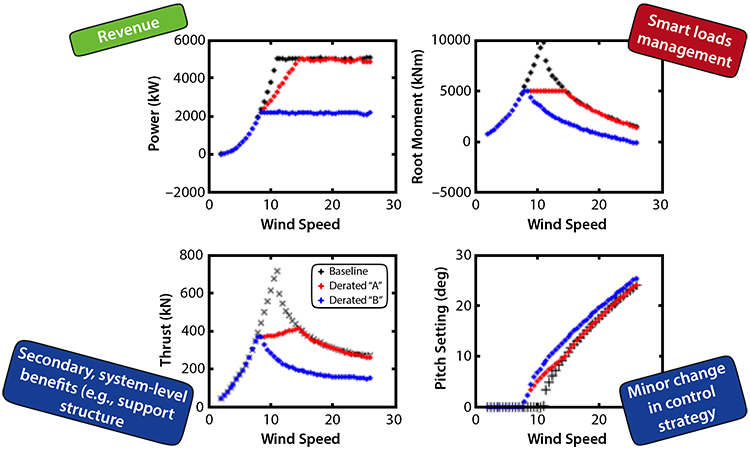Structural Health Monitoring
One of the key challenges facing the industry is to develop reliable methods to detect damage in the rotor blades early enough to improve operations and repair/maintenance decisions leading to reduced costs and increased revenues. Sandia is addressing this challenge by performing research in the areas of structural health monitoring and prognostics management. The principal motivation of this research is to reduce operations and maintenance costs, improve wind-plant reliability, and reduce downtime. A particular focus is to mitigate the large rise in costs for offshore O&M due to access difficulty, weather, high sea states, using structural health monitoring and prognostics management.
With the overall goal of significantly reducing O&M costs, we are performing research to develop a cost-effective Structural Health and Prognostics Management system that can:
- ensure operations in a desired (designed) safe state of health
- aid in planning of maintenance processes versus more costly unplanned servicing
- avoid catastrophic failures through advance warning
- improve energy capture by avoiding unnecessary shutdown and increasing overall plant availability.

Sandia has developed a technology roadmap for combining structural health monitoring and prognostics assets into a SHPM system with application to wind-turbine rotor blades. The roadmap describes six technology research and development thrust areas along with a maturation plan for each thrust area divided into five stages. Sandia has performed research in several areas specified within this roadmap.
At the core of this work is a simulation-based approach. Sandia has been simulating damaged blade conditions using a multiple-scale damage modeling and simulation methodology that was developed at the project’s onset. This simulation approach combines structural health monitoring and prognostic management to bridge the gap between being able to detect and characterize the presence of damage via sensing and then being able to make revenue-optimizing O&M decisions by evaluating the effect of damage on state of health within this single multiple-scale framework. This approach has provided a cost-effective capability to simulate and study a wide range of damage conditions. The focus of the simulations has been on issues that have led to significant turbine downtime and unavailability in the field, for example, common rotor or blade issues, including bondline damage, rotor imbalance, and pitch-angle errors. Sandia has conducted these simulations under a wide range of operating and inflow conditions to better understand the effect of actual operating conditions on damage detection capabilities.

A recent research focus has been on turbine operating strategies, that is, research on what to do once damage is identified in the rotor blades. Sandia is examining smart loads-management strategies, for example, derating strategies or prognostic control, with respect to several metrics including performance, economics, and ease of implementation. We are evaluating these strategies along with progressive damage modeling to understand the viability of safely operating damaged turbines in order to maximize energy capture versus unnecessary shutdown. Two smart loads-management strategies based on derating are shown in the left figure. Sandia is assessing and comparing the economics of these two strategies along with analyzing the effect of seasonal variability in wind speeds to understand the economic benefits of derating in high-wind-speed months versus lower-wind-speed months.
In FY14, a SHPM Working Group was initiated and led by Sandia through this project. Participation in this initiative is welcomed from all stakeholder groups with interest in this research, including those from industry, universities, and national laboratories.